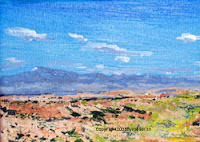 |
| My First Painting on a Board |
It being a new year and all, I thought I'd try something different--like painting on a board. I have painted only one other painting on a board, and that
was a relatively small painting, but it turned out OK, not an award winner, but
OK.
I had been admiring one painters’ technique (online), and I read that
this artist painted primarily on MDF.
So I Googled MDF, which stands for medium density fiber
board. One website said it’s wood fibers that are glued together using pressure and
heat. An artist friend also said to use Masonite™, which I found out is a
trademarked brand from what was once the Masonite Corp., named after William Henry
Mason, just fyi, in case you ever need to impress someone with your artistic knowledge.
Anyway, I visited my local big-box home improvement center
to see what they had. They had MDF, but it only came in ½-in (1.2 cm.).
pre-cut pieces, which becomes way too heavy if your painting is larger than about 16
x 12 in. (41 x 51 cm.).
They also had something labeled hardboard. I had no idea
what it was made of, but they had it in ¼ -in.(.6 cm.) and 1/8-in. (.3cm.)
thicknesses, light enough to use for large paintings. It also came in 24 x 48 in. (61 x 122 cm.) and 48 x 96-in. (122 x 244 cm.) sheets.
I decided to try the 1/8-in., 24 x 48-in. sheet, which gives
a pleasing 2-to-1 dimension, perfect for a landscape. And you can always buy the larger sheet and cut it down to any size.
When I got home, I Googled hardboard. I found out that
instead of medium density fiber board, it’s high density fiber board. Wikipedia
said it’s made of exploded wood particles, whatever that is, and it’s highly
compressed, which makes it much stronger than MDF. Not that my support needs to
be all that strong, but it’s nice to know.
I then Googled about using hardboard as a support. Several painters
said to gesso it with at least two coats, which I did.
There was also discussion about the hardboard warping, and
my board began to bend outward as the second coat of gesso dried. Oh
no.
One painter said the
solution was to gesso the backside of the board, which I did immediately.
I don’t know if using a thicker sheet would keep this from
happening, but gesso-ing the backside did the trick. When it dried, it returned
to its normal flatness after I laid it on a flat surface.
I notice that as I’m painting my landscape on the hardboard,
the board does bend as the wet acrylic is applied, but as soon as it dries, it
flattens out again. Thank goodness.
I hope this is helpful to anyone thinking about painting on
hardboard.
Keep on Painting

